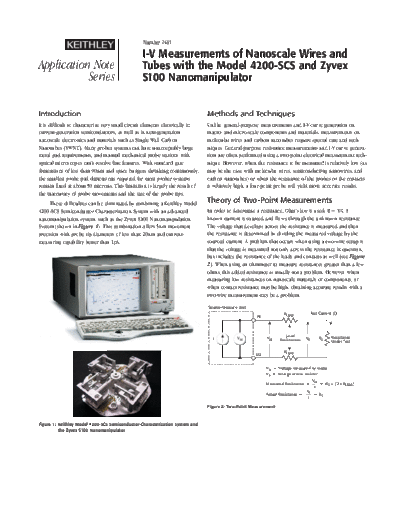Service Manuals, User Guides, Schematic Diagrams or docs for : Keithley Appnotes 2481 Zyvex App Note
<< Back | HomeMost service manuals and schematics are PDF files, so You will need Adobre Acrobat Reader to view : Acrobat Download Some of the files are DjVu format. Readers and resources available here : DjVu Resources
For the compressed files, most common are zip and rar. Please, extract files with Your favorite compression software ( WinZip, WinRAR ... ) before viewing. If a document has multiple parts, You should download all, before extracting.
Good luck. Repair on Your own risk. Make sure You know what You are doing.
Image preview - the first page of the document

>> Download 2481 Zyvex App Note documenatation <<
Text preview - extract from the document
Number 2481
I-V Measurements of Nanoscale Wires and
Application Note Tubes with the Model 4200-SCS and Zyvex
Series S100 Nanomanipulator
Introduction Methods and Techniques
It is difficult to characterize very small circuit elements electrically in Unlike general-purpose measurements and I-V curve generation on
current-generation semiconductors, as well as in next-generation macro- and micro-scale components and materials, measurements on
nanoscale electronics and materials such as Single Wall Carbon molecular wires and carbon nanotubes require special care and tech-
Nanotubes (SWNT). Many prober systems can have unacceptably large niques. General-purpose resistance measurements and I-V curve genera-
metal pad requirements, and manual mechanical probe stations with tion are often performed using a two-point electrical measurement tech-
optical microscopes can't resolve fine features. With standard gate nique. However, when the resistance to be measured is relatively low (as
dimensions of less than 90nm and space budgets shrinking continuously, may be the case with molecular wires, semiconducting nanowires, and
the smallest probe pad dimensions required for most prober systems carbon nanotubes) or when the resistance of the probes or the contacts
remain fixed at about 50 microns. This limitation is largely the result of is relatively high, a four-point probe will yield more accurate results.
the inaccuracy of probe movements and the size of the probe tips.
These difficulties can be eliminated by combining a Keithley Model Theory of Two-Point Measurements
4200-SCS Semiconductor Characterization System with an advanced In order to determine a resistance, Ohm's law is used: R = V/I. A
nanomanipulation system, such as the Zyvex S100 Nanomanipulation known current is sourced and flows through the unknown resistance.
System (shown in Figure 1). This combination offers 5nm movement The voltage that develops across the resistance is measured and then
precision with probe tip diameters of less than 20nm and current- the resistance is determined by dividing the measured voltage by the
measuring capability better than 1pA. sourced current. A problem that occurs when using a two-wire setup is
that the voltage is measured not only across the resistance in question,
but includes the resistance of the leads and contacts as well (see Figure
2). When using an ohmmeter to measure resistances greater than a few
ohms, this added resistance is usually not a problem. However, when
measuring low resistances on nanoscale materials or components, or
when contact resistance may be high, obtaining accurate results with a
two-wire measurement may be a problem.
Source-Measure Unit
RLEAD Test Current (I)
HI
Lead Resistance
I VM VM Resistances VR RS
Under Test
RLEAD
LO
VM = Voltage measured by meter
VR = Voltage across resistor
VM
Measured Resistance = = RS + (2 x RLEAD)
I
VR
Actual Resistance = = RS
I
Figure 2: Two-Point Measurement
Figure 1: Keithley Model 4200-SCS Semiconductor Characterization System and
the Zyvex S100 Nanomanipulator
Theory of Four-Point Measurements
A solution to the problem of two-point measurements that measure
the lead and contact resistance along with that of the device under test
(DUT) is the four-wire or "Kelvin" measurement. With Kelvin measure-
ments, a second set of probes is used for sensing. Negligible current
flows in these probes; therefore, only the voltage drop across the DUT
is measured (see Figure 3). As a result, resistance measurement or I-V
curve generation is more accurate.
Source-Measure Unit
RLEAD Test Current (I)
Source HI
RLEAD Sense Current (pA)
Sense HI
Lead Resistance
I VM VM Resistances VR RS
Under Test
Figure 4: I-V Curve Setup for Testing a Carbon Nanotube with the Keithley
RLEAD 4200-SCS KITE Application Program
Sense LO
RLEAD 3.00E-07
Source LO
VM = Voltage measured by meter 2.00E-07
VR = Voltage across resistor
Because sense current is negligible, VM = VR 1.00E-07
VM VR
and measured resistance = =
I I AI (Amps) 0.00E-07
Figure 3: Four-Point Measurement 0.5 0.4 0.3 0.2 0.1 0 0.1 0.2 0.3 0.4 0.5
◦ Jabse Service Manual Search 2024 ◦ Jabse Pravopis ◦ onTap.bg ◦ Other service manual resources online : Fixya ◦ eServiceinfo